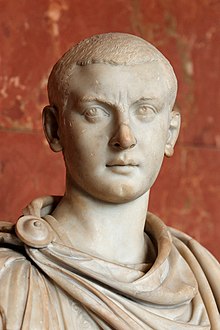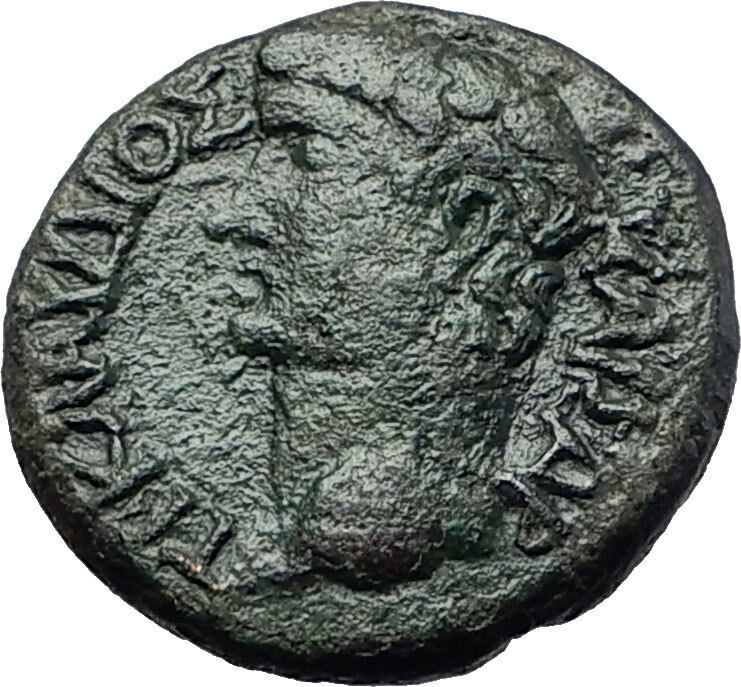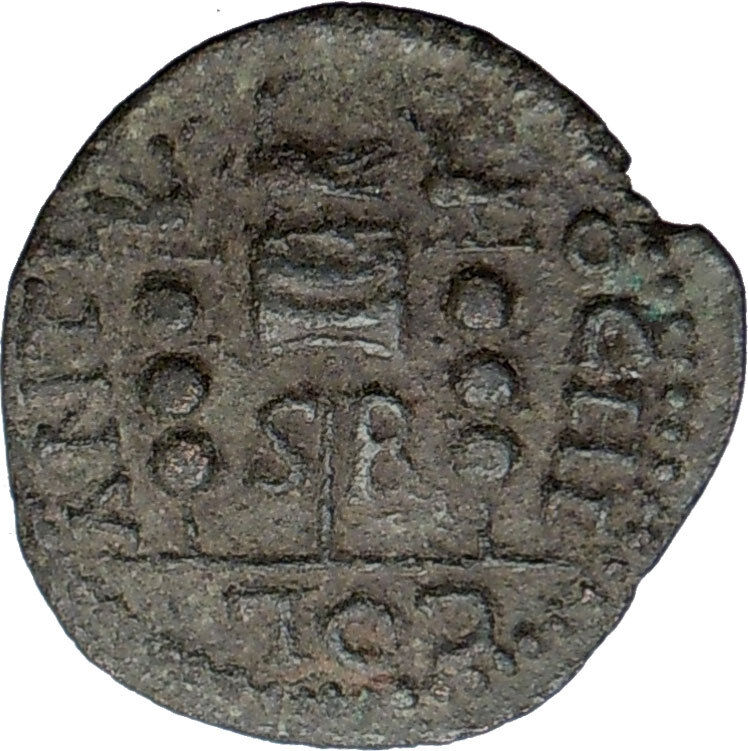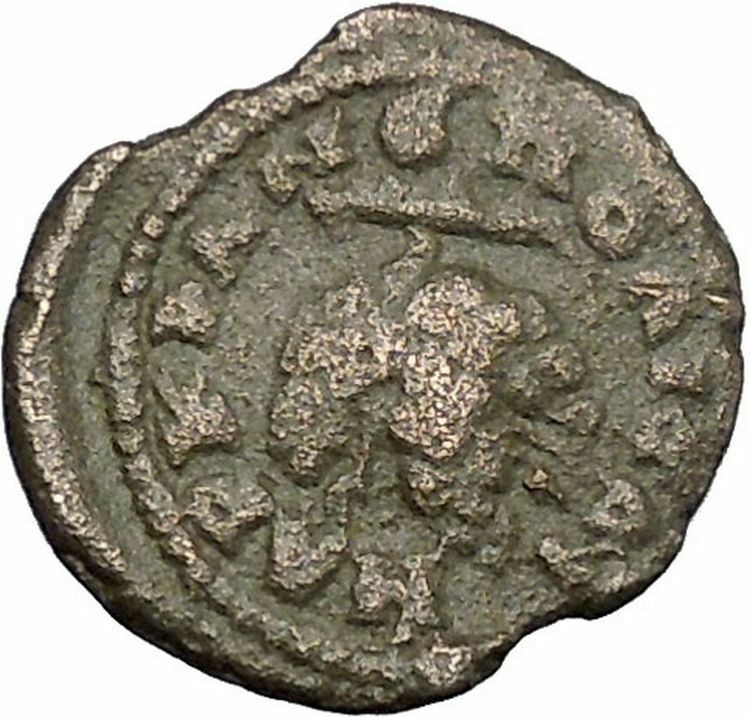|
Gordian III – Roman Emperor: 238-244 A.D.
PYTHIAN OLYMPIC-STYLE Games Issue
Bronze 24mm (8.36 grams) of Thessalonica in Macedonia
AYTO K M ANTΩNIOC ΓOPΔIANOC, Laureate, draped and cuirassed bust left.
ΘЄCCAΛONIKЄΩN ΠYΘIA, Tripod surmounted by cushion with five balls, flanked by purse and amphora.
* Numismatic Note: The reverse inscription announces the city’s celebration of the Pythian games (ΠVΘΙΑ); also by the symbol of the prize urn with the palm within it atop .
You are bidding on the exact item pictured, provided with a Certificate of Authenticity and Lifetime Guarantee of Authenticity.
The Pythian Games (also Delphic Games) were one of the four Panhellenic Games of Ancient Greece. They were held in honour of Apollo every four years at his sanctuary at Delphi.[1] They were held two years after each Olympic Games, and between each Nemean and Isthmian Games. The Pythian Games were founded sometime in the 6th century BC, and, unlike the Olympic Games, also featured competitions for art and dance. The art and dance competitions pre-dated the athletic portion of the games, and were said to have been started by Apollo after he killed Python and set up the oracle at Delphi. Otherwise, the athletic events were the same as those at the Olympic Games.
The winners received a wreath of bay laurel, sacred to Apollo, from the city of Tempe, in Thessaly. Smaller versions of the Pythian Games were celebrated in many other cities of the Levant and Greece.
Mythology
The Pythian Games supposedly start with the mythical serpent, Python. It had been sent to chase the pregnant goddess Leto by a jealous Hera. Leto managed to escape and gave birth to Artemis and Apollo. Despite being only a few days old, Apollo swore vengeance on Python and vowed to kill him. Meanwhile, Python had fled to Delphi and hidden himself there. Apollo followed him and, after a fierce battle, slew the monster with his bow. After burying the body, Apollo founded the oracle of Delphi. However, by slaying Python, Apollo had committed a crime and Zeus declared that he had to make amends. Apollo then created the Pythian Games to pay for the death. According to another version, Apollo exiled himself in the land of the Hyperboreans and founded the Pythian Games upon his return, as a sign of celebration.
History
The historical timeframe of the Pythian Games started in 582 BC, when the administration of the Games was handed over to the Delphic Amphictyony, a council of twelve Greek tribes, at the end of the First Sacred War. As of that time, they did not take place every eight years as in the past, but every four years, two years before and after the Olympic Games, presumably at the end of August.
In the beginning, only musical contests were held in the Pythian Games then extended by singing to instrumental performances. These retained great importance as also in the other big festivals, although with the new rearrangement gymnastic competitions and chariot racing were also introduced to the games.
Preparations for the games began six months prior. Nine citizens from Delphi, called Theoroi, were sent to all Greek cities to announce the beginning of the games in order to attract athletes, as well as to declare the period of the Sacred Truce (Hierominia), aiming at protecting not only the Theoroi and the athletes who travelled to Delphi, but also the temple of Apollo itself. If a city was involved in armed conflict or in robberies during that period, its citizens were forbidden to enter the Sanctuary, participate at the games, or consult the Oracle. At the same time, the truce allowed the Amphictyony to focus on preparing for the games, which included restorations for all structures of the Sanctuary, from the temples to the streets and fountains. Scores of people flocked out of entire Greece, bringing in substantial revenue to the city.
Despite the rise of Christianity in the Roman Empire during the 4th century, Delphi remained an active pagan site and the Pythian Games continued to be celebrated at least until AD 424.
Overview
Unfortunately, the testimonials and documents covering the Delphic Games were mainly destroyed through human violence and natural catastrophes. All the remaining resources highlight the glory and glamour of the Games. The records of Aristoteles present an overview about the festivities: the Games lasted for six to eight days and were started by a reenactment of the victory of Apollo over Python. In a festive and glamorous procession a ritual sacrifice was performed in the Temple of Apollo. After four days of festivities the Games began.
Events
The athletic competition included four track sports (stade, diaulos, dolichos and hoplitodromos (racing encumbered with pieces of Hoplite armor)), wrestling, boxing, pankration, and the pentathlon. These sports were introduced to the games gradually over time. The final day of the games was dedicated to equestrian races which gradually came to include harness racing, synoris (a chariot drawn by two horses), chariot drawn by four horses, and racing with a horse (without a chariot), held in a hippodrome in the plain of Krisa, not far from the sea, in the place where the original stadium was sited. (ref: Pindar) The other athletic contests took place in the Stadium.
In the Roman period theatrical competitions were introduced, carried out in the late-Hellenistic theater.
The musical disciplines included:
- A Hymn addressed to Apollo, the god of arts and music.
- Aulos (reed pipe) and kithara (an old Greek string instrument) with or without singing
- Acting and dance
- Painting
Prizes
No monetary prizes were awarded to winners in the Games. Instead they received a wreath of bay laurel, sacred to Apollo, from the city of Tempe, in ThessalyLevant and Greece.
Pindar and the Pythionikoi
Of the 45 poems composed by the Theban poet Pindar in honor of winners at the Panhellenic games, 12 were called Pythionikoi, since they were composed for winners at the Pythian Games. These special constitute a special source for the Games. In those poems, Pindar praises not only the victors, but also their families, as well as the aristocratic and athletic ideals of the late archaic period.
The Pythionikoi as a source of information
Pindar worked on lyric poetry. The largest part of his surviving works is the Victory Odes (Epinikia), chorus songs to be sung in the homeland of the winner of the Games upon his return. The Greek aristocracy of the first half of the 5th c. B.C., mostly the tyrants of Sicily and the conservative aristocracy of Aegina, constituted the clientelle of the poet. Thus, his Odes of Victory reflect the aristocratic ideals which were losing ground so fast. The winner’s laudation is reinforced by adding mythological details. However, a prerequisite for understanding and cherishing the poems is a well-educated audience. The poet uses his work not only to speak of the victory won by his client and his family, but also to accentuate the family’s history and its connections all over Greece. The total number of Victory Odes is 45 celebrating the winners in the four most famous panhellenic athletic competitions: the Olympic, the Nemean, the Pythian and the Isthmian Games. The hymns celebrating victories in Pythian Games include 12 odes and offer information on the exact competition of each athlete. Thus, we can constitute a list of the winners as follows: In 498 B.C. Hippokles from Thessaly won at the children’s diaulus (10th Pythionicus). In 490 B.C. Midas from Akragas won at the musical contests as a flute player (12th Pythionicus). In 486 B.C. Megakles from Athens won at the chariot racing (7th Pythionicus. In 475 (?) and in 474(?) B.C. Hieron of Syracuse won the chariot racing (2nd Pythionicus. In 474 Thrasydaeus from Thebes won at the children’s stadium (11th Pythionicus) and Telesikrates from Cyrene won at the armed race (9th Pythionicus). In 470 B.C. Hieron from Aetna won at the chariot racing (1st Pythinicus). Finally, in 462/1 B.C. Arkesilaus from Cyrene won at the chariot racing (4th and 5th Pythionikoi).
See also
- Ecumenical Delphic Union
- International Delphic Council
- International Delphic Committee
- Delphic Games of the modern era
Thessalonica, more anciently Therma, an ancient city in Macedonia, situated at the N.E. Extremity of the Sinus Thermaicus. Under the name of Therma it was not a place of much importance. It was taken and occupied by the Athenians a short time before the commencement of the Peloponnesian war (B.C. 432), but was soon after restored by them to Perdiccas. It was made an important city by Cassander, who collected in this place the inhabitants of several adjacent towns (about B.C. 315), and who gave it the name of Thessalonica, in honor of his wife, the daughter of Philip and sister of Alexander the Great. From this time it became a large and flourishing city. Its harbor was swell situated for commercial intercourse with the Hellespont and the Aegean; and under the Romans it had the additional advantage of lying on the Via Egnatia, which led from the W. shores of Greece to Byzantium and the East. It was visited by Apostle Paula about A.D. 53; and about 2 years afterwards he addressed from Corinth 2 epistles to his converts in the city. Thessalonica continued to be, under the empire, one of the most important cities of Macedonia; and at a later time it became the residence of the prefect, and the capital, of the Illyrian provinces. It is celebrated at this period on account of the fearful massacre of its inhabitants by order of Theodosius, in consequence of a riot in which some of the Roman officers had been assassinated by the populace.

Gordian III – Roman Emperor: 238-244 A.D.
Caesar: 238 A.D. (under Balbinus and Pupienus)
Augustus: 238-244 A.D.
| Grandson of Gordian I | Nephew of Gordian II | Adopted Successor of Balbinus and Pupienus | Husband of Tranquillina |
Marcus Antonius Gordianus Pius (January 20, 225 – February 11, 244), known in English as Gordian III, was Roman Emperor from 238 to 244. Gordian was the son of Antonia Gordiana and his father was an unnamed Roman Senator who died before 238. Antonia Gordiana was the daughter of Emperor Gordian I and younger sister of Emperor Gordian II. Very little is known on his early life before becoming Roman Emperor. Gordian had assumed the name of his maternal grandfather in 238.
Following the murder of emperor Alexander Severus in Moguntiacum (modern Mainz), the capital of the Roman province Germania Inferior, Maximinus Thrax was acclaimed emperor, despite strong opposition of the Roman senate and the majority of the population. In response to what was considered in Rome as a rebellion, Gordian’s grandfather and uncle, Gordian I and II, were proclaimed joint emperors in the Africa Province. Their revolt was suppressed within a month by Cappellianus, governor of Numidia and a loyal supporter of Maximinus Thrax. The elder Gordians died, but public opinion cherished their memory as peace loving and literate men, victims of Maximinus’ oppression.
Meanwhile, Maximinus was on the verge of marching on Rome and the Senate elected Pupienus and Balbinus as joint emperors. These senators were not popular men and the population of Rome was still shocked by the elder Gordian’s fate, so that the Senate decided to take the teenager Gordian, rename him Marcus Antonius Gordianus as his grandfather, and raise him to the rank of Caesar and imperial heir. Pupienus and Balbinus defeated Maximinus, mainly due to the defection of several legions, namely the ParthicaII who assassinated Maximinus. But their joint reign was doomed from the start with popular riots, military discontent and even an enormous fire that consumed Rome in June 238. On July 29, Pupienus and Balbinus were killed by the Praetorian guard and Gordian proclaimed sole emperor.
Rule
Due to Gordian’s age, the imperial government was surrendered to the aristocratic families, who controlled the affairs of Rome through the senate. In 240, Sabinianus revolted in the African province, but the situation was dealt quickly. In 241, Gordian was married to Furia Sabinia Tranquillina, daughter of the newly appointed praetorian prefect, Timesitheus. As chief of the Praetorian guard and father in law of the emperor, Timesitheus quickly became the de facto ruler of the Roman empire.
In the 3rd century, the Roman frontiers weakened against the Germanic tribes across the Rhine and Danube, and the Sassanid kingdom across the Euphrates increased its own attacks. When the Persians under Shapur I invaded Mesopotamia, the young emperor opened the doors of the Temple of Janus for the last time in Roman history, and sent a huge army to the East. The Sassanids were driven back over the Euphrates and defeated in the Battle of Resaena (243). The campaign was a success and Gordian, who had joined the army, was planning an invasion of the enemy’s territory, when his father-in-law died in unclear circumstances. Without Timesitheus, the campaign, and the emperor’s security, were at risk.
Marcus Julius Philippus, also known as Philip the Arab, stepped in at this moment as the new Praetorian Prefect and the campaign proceeded. In the beginning of 244, the Persians counter-attacked. Persian sources claim that a battle was fought (Battle of Misiche) near modern Fallujah (Iraq) and resulted in a major Roman defeat and the death of Gordian III. Roman sources do not mention this battle and suggest that Gordian died far away, upstream of the Euphrates. Although ancient sources often described Philip, who succeeded Gordian as emperor, as having murdered Gordian at Zaitha (Qalat es Salihiyah), the cause of Gordian’s death is unknown.
Gordian’s youth and good nature, along with the deaths of his grandfather and uncle and his own tragic fate at the hands of another usurper, granted him the everlasting esteem of the Romans. Despite the opposition of the new emperor, Gordian was deified by the Senate after his death, in order to appease the population and avoid riots.
|











